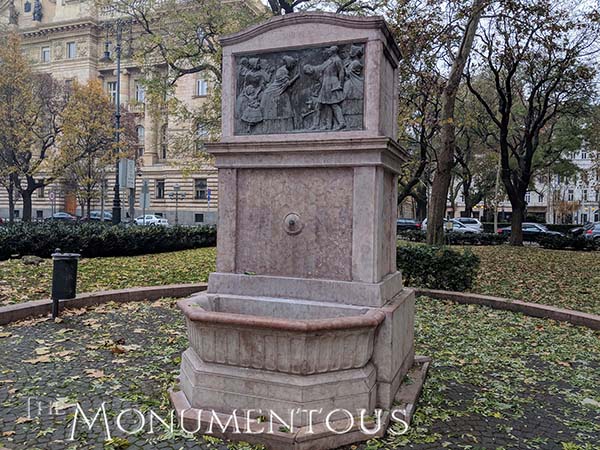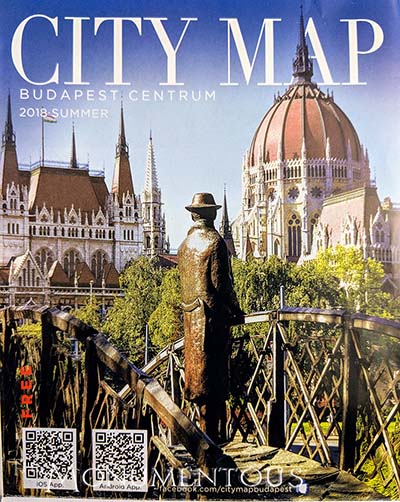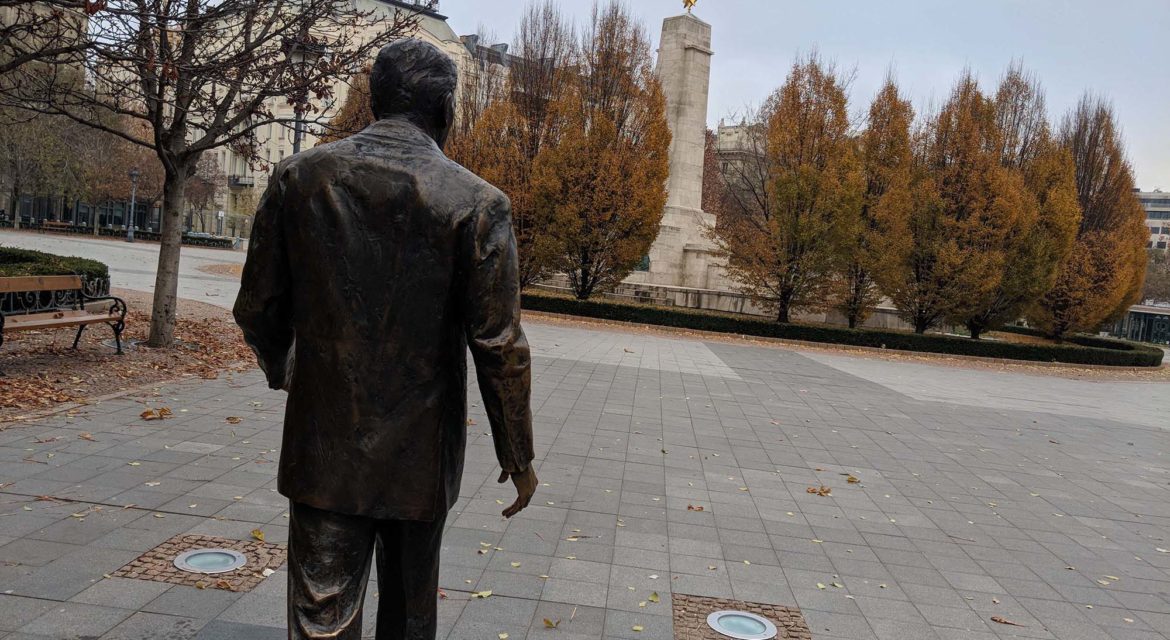 Spaces and places have been completely transformed as a result of the installation or removal of monuments, and nowhere is the power of such structures to influence this kind of transformation apparent than at Freedom Square (Szabadság tér) in Budapest, Hungary. The Square contains numerous monuments erected at different times that represent numerous eras and ideals, and the juxtaposition between periods and perspectives that this combination has enabled is as striking as it is illuminating.
Spaces and places have been completely transformed as a result of the installation or removal of monuments, and nowhere is the power of such structures to influence this kind of transformation apparent than at Freedom Square (Szabadság tér) in Budapest, Hungary. The Square contains numerous monuments erected at different times that represent numerous eras and ideals, and the juxtaposition between periods and perspectives that this combination has enabled is as striking as it is illuminating.
Freedom Square is a perfect illustration of what can happen when monuments take on a significance that represents something much bigger to a city and even for a nation.

A Combination of Historic, Commercial, and Residential Space
The space for what would become Freedom Square was cleared at the end of the nineteenth century, and notable buildings such as the Stock Exchange Building (Tőzsdepalota) and the Hungarian National Bank Building (Magyar Nemzetí Bank) were erected not long after. The U.S. Embassy Building (Chancery Building) is also located in Freedom Square, which has housed diplomats since 1935. All of these buildings and activities influenced how the Square would become a combination of historic, commercial, and residential space that houses everything from playgrounds to a post office to a coffee shop.
This combination partially explains why Freedom Square contains monuments that honor Soviets, Jews, Americans, Hungarians and others, although monuments have been incorporated into the space since the beginning. A monument installed in the early 1900s was one of the pieces erected in protest of the 1920 Treaty of Trianon, which resulted in the loss of almost three-quarters of Hungary’s territory. It was eventually replaced by a Soviet Monument that honors the soldiers of the Red Army who died in 1944-1945 during the liberation of Budapest. That replacement has come to illustrate the contrast and juxtaposition that subsequent monuments installed in Freedom Square represent.
 During World War II, the Soviet Union fought to liberate Hungary from Nazi conquest, but the Soviets eventually came to be seen as similarly oppressive. That perception fueled the end of communism in the country, which in turn saw the removal and transformation of various Soviet monuments throughout Budapest. Unlike other monuments that have seen their symbolism transformed, the Soviet Monument in Freedom Square is very much identified with its’ original purpose, mostly due to the crest showing the Communist hammer and sickle along with a bas-relief of Soviet soldiers engaged in battle. However, the removal of the piece goes beyond the symbolism of doing so, as soldiers are buried under it.
During World War II, the Soviet Union fought to liberate Hungary from Nazi conquest, but the Soviets eventually came to be seen as similarly oppressive. That perception fueled the end of communism in the country, which in turn saw the removal and transformation of various Soviet monuments throughout Budapest. Unlike other monuments that have seen their symbolism transformed, the Soviet Monument in Freedom Square is very much identified with its’ original purpose, mostly due to the crest showing the Communist hammer and sickle along with a bas-relief of Soviet soldiers engaged in battle. However, the removal of the piece goes beyond the symbolism of doing so, as soldiers are buried under it.
In an effort to combat the symbolism and message of this monument, a series of other pieces have been installed over the years, starting in 1996, with the installation of a statue of Imre Nagy, who led Hungary’s anti-Soviet 1956 uprising. In 2011 a bronze statue of Ronald Reagan was installed, while a statue of Major General Harry Hill Bandholtz has been standing in front of the US Embassy for far longer. All of these pieces have stirred different levels of feedback and controversy, but none more than the Memorial to the victims of the German invasion installed in 2014.
 Announced at the end of 2013 to mark the 70th anniversary of the year Nazi Germany invaded Hungary, the piece depicts a bronze eagle swooping down on the Archangel Gabriel. The eagle is supposed to represent Germany while Gabriel represents Hungary, and one of the eagle’s talons even has the year “1944” on its talon. Critics accuse the Hungarian government of attempting to absolve the Hungarian regime in power during the war by putting the blame of the war entirely on Nazi Germany. World War II saw the death of nearly one million Hungarians, including two-thirds of its Jewish population.
Announced at the end of 2013 to mark the 70th anniversary of the year Nazi Germany invaded Hungary, the piece depicts a bronze eagle swooping down on the Archangel Gabriel. The eagle is supposed to represent Germany while Gabriel represents Hungary, and one of the eagle’s talons even has the year “1944” on its talon. Critics accuse the Hungarian government of attempting to absolve the Hungarian regime in power during the war by putting the blame of the war entirely on Nazi Germany. World War II saw the death of nearly one million Hungarians, including two-thirds of its Jewish population.
The contradictions that all of these monuments represent when compared to one another and even when compared to the events or people they’re supposed to be commemorating are incredibly stark. Various other monuments that haven’t generated as much controversy are also spread across the space, and the conversations and engagement all of these pieces have been able to generate has helped draw people and attention to the area.

Driving and Representing Change for Budapest
 The juxtaposition of monuments, buildings and scenery throughout Freedom Square provides an incredible example of how monuments can be utilized to influence a space. All of the monuments in Freedom Square function independently of one another, but it’s impossible to ignore the contrasts and clashes these pieces represent when considered in the wider context of the Square, which is some cases is the exact reason they were erected.
The juxtaposition of monuments, buildings and scenery throughout Freedom Square provides an incredible example of how monuments can be utilized to influence a space. All of the monuments in Freedom Square function independently of one another, but it’s impossible to ignore the contrasts and clashes these pieces represent when considered in the wider context of the Square, which is some cases is the exact reason they were erected.
The statue of Ronald Reagan looks as if the figure is about to casually stroll by the Soviet Monument, which directly and indirectly references the stand Reagan took against communism. Similarly, while makeshift and heartfelt memorials dedicated to the people who lost their lives in World War II have been set up near the Memorial to the victims of the German invasion, many are focused on the larger symbolism of the piece.
Some felt that the Hungarian government should have engaged with a wider community to make decisions about a monument that would commemorate the 70th anniversary of Hungary’s Nazi occupation. The 2013 installation of a bust of Admiral Miklós, who served as the Regent of Hungary during World War II, near the Square has also caused a great deal of attention and criticism.
 All of that exists in the midst of a hub of activity for both tourists and residents. A coffee shop sits in the middle of the Square, while playgrounds on the margins of both sides of the Square encourage a much different kind of activity. Images of the monuments in the Square appear on maps and guides for tourists. Concerts and festivals take place on a regular basis at Freedom Square, which also features decorations and activities related to the season. All of this underscores the legacy and history that Freedom Square has come to signify and will see continually evolve.
All of that exists in the midst of a hub of activity for both tourists and residents. A coffee shop sits in the middle of the Square, while playgrounds on the margins of both sides of the Square encourage a much different kind of activity. Images of the monuments in the Square appear on maps and guides for tourists. Concerts and festivals take place on a regular basis at Freedom Square, which also features decorations and activities related to the season. All of this underscores the legacy and history that Freedom Square has come to signify and will see continually evolve.

Shaping the History and Legacy of a Nation
 Freedom Square has been part of, and represents, centuries of history for Hungary and Budapest. While the city is home to numerous monuments that honor and celebrate many different aspects of this history, the monuments in Freedom Square do so in ways that juxtapose how this history can and should be actively considered by both residents and visitors. It challenges viewers and engages them in ways few monuments have enabled.
Freedom Square has been part of, and represents, centuries of history for Hungary and Budapest. While the city is home to numerous monuments that honor and celebrate many different aspects of this history, the monuments in Freedom Square do so in ways that juxtapose how this history can and should be actively considered by both residents and visitors. It challenges viewers and engages them in ways few monuments have enabled.
Freedom Square illustrates how Hungary is dealing with its Soviet-dominated past and showcases the power monument have to shape these histories and legacies in the present and future.

